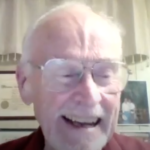The Text of ACIM (Chapters 1 through 7) mentions that we have an upside-down view of our world. It is important that we realize and understand how we are viewing our world upside down, i.e., we do not see the world for what it is. The term “upside-down” has the reverse or opposite meaning of “right-side-up.” So, we could say that the Course is stating that we are seeing our world in the reverse or opposite as it is.
If we are unable to see our world as it is, it follows that until we correct our view of the world, our chances of understanding what seems to be happening in our world are nil. Consequently, the decisions we make about our lives and other peoples’ lives cannot be very good! So, it is imperative that we begin to see our world as it really is.
Our first clue to seeing our world (as it really is) comes from the summary of the introduction to the Course:
“Nothing real can be threatened.
Nothing unreal exists.” (T-in.2:2-3)
In addition to being a great two-line summary of the Course, this gives us some insight into our world. If nothing real can be threatened, and recognizing that we live in a world fraught with threats; we can conclude that the Course is telling us that our world is unreal; especially if nothing unreal exists! And, given our world is unreal, just maybe, it is an illusion. The word “dream” is synonymous with the word “illusion,” and the Course uses these two words interchangeably.
The Course is very clear about the difference between these two groups of words:
“Create, creating, and created,” and “make, making, and made.” (T-5.V.2:2)
The difference being, what God has Created is Real and changeless; and in the dream of the world, the things that seem to be made by us are part of the dream, i.e., not real. (T-30.VIII.1)
There are more distinctions to be made:
Ergo, if something is subject to change, it cannot be real; if it is not real it does not exist, and this applies to everything in the dream. According to the Course, the Mind of God is all that exists, and the Mind of God is all that is Real. (W-183.8)
So, we cannot argue that something is real because it exhibits physical properties. The entire physical universe is an illusion, i.e. unreal! When we dream at night, it is obvious that we make an entire physical universe within our dream to support our dream, and the things in our dream do exhibit physical properties, e.g., being solid, wet, dry, hot, cold, light, heavy, etc.
We think we have sleeping (dreaming) times; usually at night, and awake times (not dreaming); usually during the day. Actually, we are asleep and dreaming all the time – 24/7/365. (T-18.VII.3)
Another upside-down view that most of us have of ourselves is that we are victims of chaotic forces beyond our control. Au contraire! The Course tells us that we are in total control of what seems to happen to us in our dream! (T-11.III.1) & (T-18.II.5) Actually there are at least 30 Course quotes that tell us that we are in total control of our dream of the world! Our guilt demands punishment and it attracts unpleasant events to us. (T-13.I.8) The only way for us to get rid of guilt is by completely forgiving ourselves and other people. (T-13.VI.1), (T-17.III.1), (W-186.1–8)
Psychologists tell us that when we dream, the people who are in our dream with us, are just us pretending to be them, i.e., our dream is in our mind and we are in complete control of our dream. Other people who are seemingly in our dream are always being directed by us. Since the Course tells us that our “daytime dream” and our “nighttime dream” are the same dream (see above), it follows that the people in our “daytime dream” also behave exactly as we want them to!
This discussion would not be complete unless we discuss the phrase “I need do nothing” that appears in Course Chapters 16 (T-16) and 18 (T-18), and Course Lesson 337 (W-337). The “keyword” here is “do,” and “do” needs to be defined when used in this context. This is one of the most misunderstood (implying we have an upside-down view) Lessons in the Course. To “do” something (anything) implies a physical change. And since change only seems to “happen” in the illusion, and so-called “physical matter” is part of the illusion, the word “do” is only appropriate when referring to matter in the illusion (what the Course refers to as the level of perception). And since “doing nothing” is synonymous with “not doing anything,” i.e., nothing is ever really changed in an illusion.
The Course phrase, “I need do nothing” is an indication that nothing can be done in the illusion, but a change of mind is required – which is the only place real change can happen. When we change our mind, we have done nothing because the verb “to do” is only applicable within the illusion. When we change our minds with the help of the Holy Spirit, healing of the mind occurs.
Finally, what the Course is telling us, is that the illusion we have been referring to as “real” is actually “unreal,” and what we have been referring to as something “unreal (the mind)” is actually all there is that is real! This is another example of the Course telling us that we have an upside-down view of the world.
Raymond Wells has been a student of A Course In Miracles since 1985, and a teacher of the Course since 2014. He holds a BS degree in electrical engineering. His book, “A Course in Miracles CLARIFIED” is available from amazon.com.
